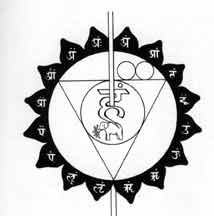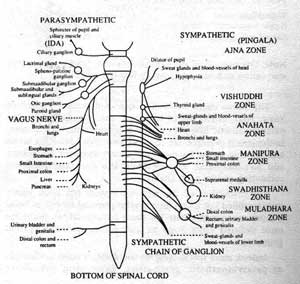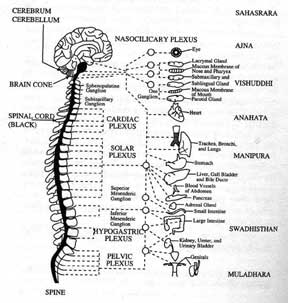|
|
|
 |
KUNDALINI
CHAKRA-DHARANA :
FOCUSING PSYCHIC POWER
SCIENTIFIC STUDY |
|
|
|
| We may say that a Yantra is an
instrument, designed to curb the psychic forces by concentrating them in a
pattern, and is such a way that this pattern becomes reproduced by the
worshipers visualizing power. -
Heinrich Zimmer, Ph.D., Indologist
|
|
| It has been suggested by several
modern schools of Yoga that the chakras, with their associated symbology,
represent nothing more than a method of forcing the mind to concentrate upon
the body. This may be so, especially
when we consider that one of the literal meanings of the Sanskrit Laya is
absorption. Such absorption, or concentration of the mind upon the body, would
lead to the opening or harmonizing of the chakras and their respective
psycho-physical functions.
Harmonizing the chakras implies an ancient chime
of psychic anatomy that corresponds with our western physical, or
gross/macroscopic anatomy, of the central and autonomic nervous systems.
Consider the following correlative analysis.
|
|
| Central Nervous System |
| Divided into brain and spinal
cord. |
|
| Brain: Cerebrum and
cerebellum. A midline sagittal slice resembles the fetus, symbol of latent
growth, the neophyte, or Sahasrara padma - i.e., full potential yet to be
released. |
| Spinal cord: Averages
eighteen inches in length. Eighteen is the Hindu number of completeness. In the
Mahabharata we note the eighteen days of the Great Battle, the eighteen
battalions that fought, and the eighteen chapters of the Bhagavad-Gita
("Song of God"). When the spinal cord is dissected out of the vertebral column,
along with the brain cone, it resembles a serpent (Kundalini), while the cavity
of the spinal canal is sushumna. The spinal cord transmits sensory (afferent)
messages to the brain and receives motor (afferent) signals from the brain down
its tracts to produce changes in effectors (i.e., muscles and glands). The
sensory nerve tracts of the spinal cord represent Ida (receptive, passive)
functions while motor nerve tracts down the spinal cord are equivalent to
Pingala (projective, active) functions. |
| Autonomic Nervous system |
| It was formerly called involuntary, and even
earlier (nineteenth century), the vegetative nervous system, as it was thought
to govern functions beyond conscious regulation-e.g., heart rate, blood
pressure, respiration, digestive functions, etc. However, by the 1970s Elmer
Green, Ph.D., was able to prove that voluntary control could be established
through a combination of biofeedback and autogenic training. The
autonomic nervous system divides into two sections which constantly interact
with each other, either for dominance (according to need) or functional
integration.
|
 |
|
| Sympathetic Branch: Left
and right chains of ganglion, tethered to the spinal cord but running down each
side of the anterior bodies of the vertebral column, and averaging twenty-two
ganglion a piece, spread out from the coccyx up to the cervical vertebrae. This
symmetry is reminiscent of Ida and Pingala with Sushumna, the spinal canal, as
the "Middle Pillar" of Western Magical practice. The twenty-two ganglion
represent the number of the Avatar, or coming savior in Hinduism, and in
Western occult anatomy the twenty-two ganglion correspond to the twenty-two
paths on the Qabalistic Tree of Life, twenty-two letters of the Hebrew
Alphabet, twenty-two bones of the skull (used as a "communion cup" a sin the
Nordic Skoal), and the twenty-two cards of the Major Arcana in the Tarot.
Functionally the sympathetic nerves most often act as an accelerator, producing
pingala reactions, an extreme example being the so called "fear, fight, flight"
syndrome. |
|
| Parasympathetic branch: The
major section comprises a pair of vagus (in English, "vagrant") nerves, which
emerge from the base of the skull to wander down the neck, through the chest,
and deep into the abdominal cavity. Again remember the symbolic twins: Boaz and
Jachin, Ida and Pingala. Parasympathetic branch fibers constantly meet with
sympathetic branch fibers to form plexuses, the major ones on the physical
plane representing the materialization of the non-physical chakras.
Functionally the parasympathetic nerves most often perform braking actions; I
call them the "rest, relaxation, recuperation" fibers, and hence they may be
allied to Ida reactions. |
|
| A Few simple examples may help us
relate to the autonomic nervous system in a meaningful way. |
| Organ or system |
Sympathetic Action |
Parasympathetic Action |
| Pupils of eyes |
DILATE: Better to see
with if interested or frightened. |
CONSTRICTS: No threat,
so every photon of light not necessary. |
| Heart rate |
INCREASED:
Tachycardia. If frightened or anxious, more oxygen and glucose pumped around
faster. |
SLOWED: Bradycardia.
Safe to relax and rest. |
| Hand temperature |
COLD: Principle of
"Brain sparing." Blood is with-drawn from extremities and saved for the heart
and brain. |
WARMED: Vanishes cold
hands. Many types of meditation do this. |
| Sleep |
HYPER-ALERTNESS:
Anxiety, insomnia. |
Deep sleep comes
easily. |
| MALE SEXUAL FUNCTION |
|
|
| Erection |
Inhibits if nervous,
as arteriole blood supply constricted to penis. |
Allows full erection. |
| Ejaculation |
Sympathetic arousal at
right level is necessary for ejaculation. |
Inhibits ejaculation. |
| FEMALE SEXUAL FUNCTION |
|
|
| Vaginal lubrication |
Inhibits
|
Promotes |
| Nipple tumescence
|
Inhibits
|
Promotes |
| Clitoral tumescence
|
Inhibits
|
Promotes |
|
| Note: Overarousal of the
sympathetic may lead to premature ejaculation and also ejaculation without
erection. |
|
| The above examples demonstrate a
delicate "union", or Yoga, that must occur between the sympathetic and
parasympathetic branches of the autonomic nervous system. In the sexual
example, we could express it in Laya Yoga terms and say that a fine balance is
necessary between Muladhara and Swadhisthana, and between the God and Goddess
cohabiting within each chakra. The
discussion of the nervous system has been vastly oversimplified but it can form
a solid physical matrix to build a much more subtle base for inner
concentration. Someone once defined Laya Yoga as autonomic nervous system
gymnastics.
Indeed more specifically, we could define most
meditation as parasympathetic gymnastics
|
|
INTRODUCTION TO
CHAKRA DHARANA
|
|
 |
Yoga postulates that the focus of psychic power
may be developed through concentration (Dharana) upon the chakra zones. The
result is dispersion of psychosomatic tension that so often occurs at one or
more of these vital zones. |
|
|
| An analogous situation is
autogenic training, developed in the early part of the twentieth century when
the German psychiatrist Dr. Johannes H. Schultz amalgamated Yoga methodology
with a then current European fascination-hypnosis. For example, concentrating
upon the hands, visualizing them flushing red with blood, and telling yourself
they are getting warm will actually raise the hand temperature by as much as
ten degrees Fahrenheit, depending on your starting point. |
|
| This type of autogenic training is
a form of "Western Yoga" and works exactly the same way as most meditation
methods. The sympathetic nervous system is dampened, allowing the peripheral
arterioles to dilate and flood the extremities with blood. By now you will have
empirically discovered that successful meditation is always accompanied by an
end result of warm hands and feet. |
|
 |
In the initial stages, the mind is best trained
by giving it something concrete upon which to concentrate. This is the purpose
of the elaborate symbology. Each chakra has a certain number of petals, and
each petal is inscribed with a letter of the Sanskrit alphabet (this is for
awakening the chakra through Mantra Yoga), an animal, a god and goddess, a
geometric form, a color, and a Bija, or seed, mantra. All
that will be necessary, for our purposes, will be a knowledge of the last three
symbolic components: color, form, and Bija mantra.
The form and color of the first five chakras
represent the Tattwa, or element, assigned to each. The Bija mantra is a basic
sound which groups or awakens the dormant energy of the individual chakra.
|
|
|
| Chakra |
Two dimensional geometric form |
Color |
Body Space |
| Muladhara |
Square |
Yellow |
Gonads, pelvic floor |
| Swadhisthana |
Crescent moon |
Silver |
Between pubic bone and navel |
| Manipura |
Triangle, apex down |
Red |
Between navel and breast bone tip |
| Anahata |
Hexagram |
Blue |
Behind breast bone, roughly on a
line between nipples |
| Vishuddha |
Oval(egg) |
Black |
Inside "Voice Box" |
|
|
| Specific Advantages of Chakra
Dharana |
|
| 1. Concentration and visualization
are improved. 2. Eastern occult theory
states that this technique of concentration is one of the safest and most
natural ways of gently awakening and harmonizing the psychic centers.
3. Relaxation of psychosomatic tension, in any
specific chakra body space, develops by focusing upon that chakra within its
area.
4. Traditional psychological characteristics are
encouraged by meditating upon chakra areas with the appropriate color, sound,
and shape.
|
|
| Chakra |
Three Dimensional geometric
form |
Psycholigical attributes |
| Muladhara |
Cube |
Solidarity, cohesiveness,
Integration |
| Swadisthana |
Crescent |
Diplomacy, flexibility, equanimity |
| Manipura |
Tetrahedron |
Power, passion, energy, motivation |
| Anahata |
Hexagram |
Compassion, tolerance,
understanding |
| Vishuddha |
Egg |
Empathy, Communication, freedom |
|
|
|
|
|
|